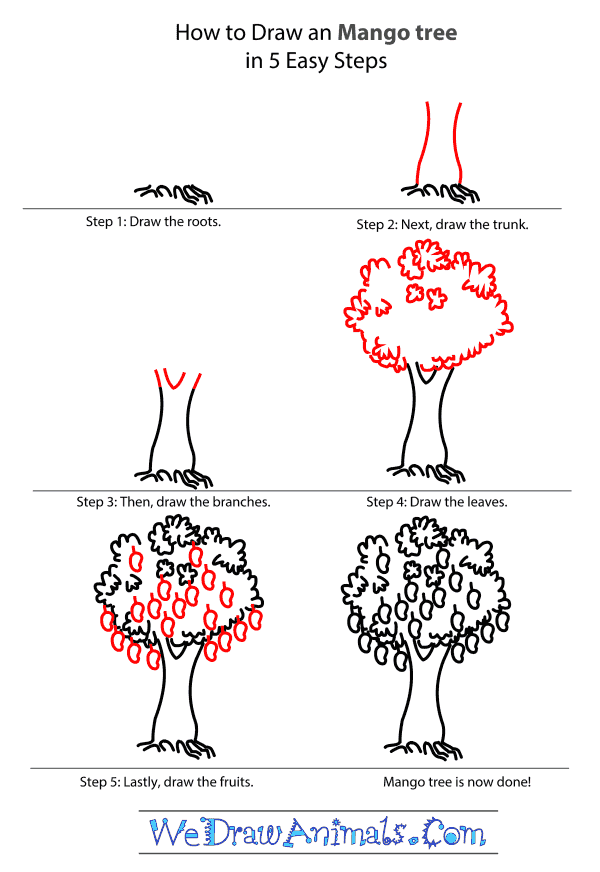In this quick tutorial you'll learn how to draw a Mango Tree in 5 easy steps - great for kids and novice artists.
The images above represents how your finished drawing is going to look and the steps involved.
Below are the individual steps - you can click on each one for a High Resolution printable PDF version.
At the bottom you can read some interesting facts about the Mango Tree.
Make sure you also check out any of the hundreds of drawing tutorials grouped by category.
How to Draw a Mango Tree - Step-by-Step Tutorial
Step 1: First, draw the roots. Draw a few wavy lines in a small row.
Step 2: Draw the trunk next. Draw a long line on both sides of your roots that dip in toward the middle and come back out.
Step 3: Then, draw the branches of the tree. Extend the lines that come out a line from your trunk and then draw a curved “V” on the inside of those lines.
Step 4: Now, it’s time to draw the leaves. In the shape of a circle where the bottom is the top of the trunk, draw small little humps. Add a bundle of small humps on the inside of your tree to add detail.
Step 5: Finish by drawing the fruit. To draw a mango, draw an oval that dips in a little toward the bottom of one side. Add a small line going up from the top of the mango to look like it is hanging off of the tree. Repeat this all over the tree.
Interesting Facts about Mango Trees
Mango Trees grow naturally in Southeast Asia and Eastern India. They are a tropical plant that can grow to 115 to 130 feet tall. When a Mango Tree first produces its leaves they are purple, and then turn a dark green. The fruit is round and can be red or yellow in color. The fruit appears after the tree flowers which are a small bunch that will bloom together. Mango Trees produce mango fruit which is like a pear in shape, but has its own unique taste. Some compare it to a peach. Mangos will ripen on a tree 4 to 5 months after the flower bunches bloom.
Did you know?
- Buddhist teachings say that Buddha found his inner peace under a Mango Tree. For this reason Buddhist monks are credited with introducing the Mango Tree to new areas.
- Mangos can be found all year round.
- India is the highest producer of mangoes, but they only export 1 percent of them. It is a very popular fruit in Indian food.
- The paisley pattern (a pattern of sideways tear drop shapes and polka dots) is thought to be inspired by mango fruit.
- A Mango Tree can still produce fruit after 300 years!
Theme: Mangos can be served in a variety of ways. Choose a recipe that suits your family’s taste and introduce them to the mango.






